Gary Nichols. Sedimentology and Stratigraphy(Second Edition)
Подождите немного. Документ загружается.

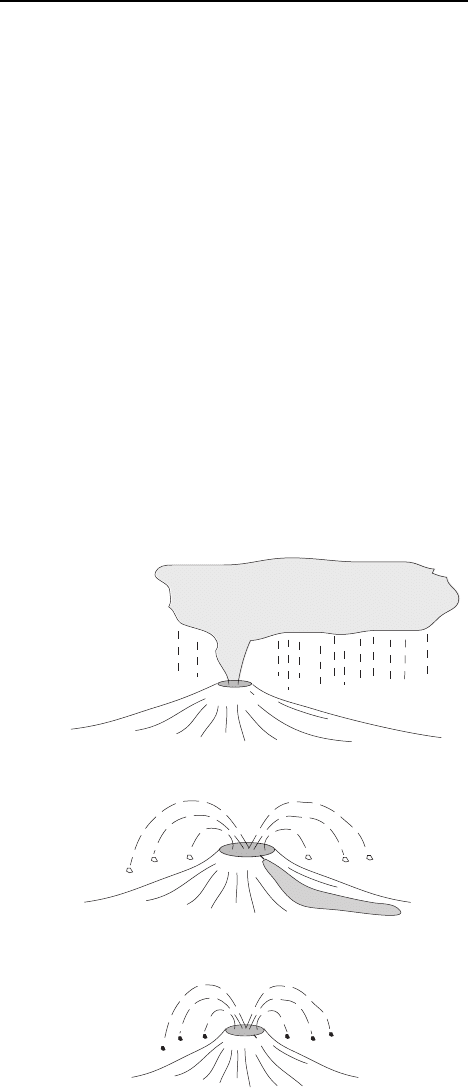
17.2.5 Volcanic debris-flow avalanches
Structural collapse of part of a volcano can result in
catastrophic avalanches of material downslope as a
debris-flow avalanche. They may be triggered by
explosive eruptions, volcanic earthquakes or by the
oversteepening of the side of a volcanic edifice due to
addition of material during eruption, such that part of
it fails under gravity. Large amounts of unstable vol-
canic material move downslope under gravity includ-
ing blocks that may be tens to hundreds of metres
across in a matrix of finer-grained volcanic ash
(Urgeles et al. 1997). The deposits of these vents are
extremely poorly sorted, chaotic masses of detritus
that may be tens to hundreds of metres thick and
cover hundreds of square kilometres. Where water is
involved in the debris-flow avalanche it may pass into
a lahar (see below).
17.2.6 Lahars
A lahar is a debris flow (4.5.1) that contains a sig-
nificant proportion of material of volcanic origin.
They form as a result of mixing of unconsolidated
volcanic material with water and the subsequent
movement of the dense mixture as a sediment gravity
flow (Smith & Lowe 1991). Lahars can form during
or immediately after an eruption where pyroclastic
material is erupted into or onto water, snow or ice
and when heavy rains contemporaneous with the
eruption fall on freshly deposited ash. Mobilisation
of wet ash can also result in a lahar in circumstances
where the ground is disturbed by an earthquake
or there is a failure of a temporary lake formed
by erupted material. Remobilisation of wet volcanic
detritus can occur at any time after eruption, and
some lahars may be unrelated to volcanic activity,
including cases where epiclastic volcaniclastic debris
is involved.
The characteristics of a lahar are essentially the
same as those of other debris flows, with the distinc-
tion being the composition of the material deposited.
The deposits are very poorly sorted and often matrix-
supported with no sedimentary structures. Lahars can
be readily distinguished from primary volcaniclastic
deposits where there is a mixture of terrigenous clastic
and volcaniclastic detritus, but where all the material
is of volcanic origin, there can be similarities between
lahars and pyroclastic flow deposits.
17.3 ERUPTION STYLES
17.3.1 Plinian eruptions
Plinian eruptions are large, explosive eruptions
involving high-viscosity magmas of andesitic to rhyo-
litic composition. They involve large quantities of
pumice that are ejected to form extensive pumiceous
pyroclastic fall deposits over hundreds of square
kilometres. Close to a vent the deposits of a single
eruption may be 10 or 20 m thick: the distribution of
material depends on the magnitude of the eruption,
but deposits a metre thick can be found tens of kilo-
metres away from the vent (Cas & Wright 1987). The
deposits are typically clast-supported, angular, frag-
mented, pumice or scoria clasts with subordinate
crystals and lithic fragments. The fabric may be mas-
sive or stratified, the former resulting from sustained
eruptions, whereas stratification may result from fluc-
tuations of eruption intensity or wind direction
(Fig. 17.5). The bedding of Plinian falls tends to mantle
Plinian
Stombolian/Hawaiian
Vulcanian
Gas-driven eruption of ash forms
large ash cloud
ash deposits 100s km
from vent
cinder cone
1-10 km radius
lava flow
molten lava splatter
solid lava fragments ejected
deposits close to vent
Fig. 17.5 Pele
´
e, Merapi and St Vincent types of pyroclastic
flow.
268 Volcanic Rocks and Sediments
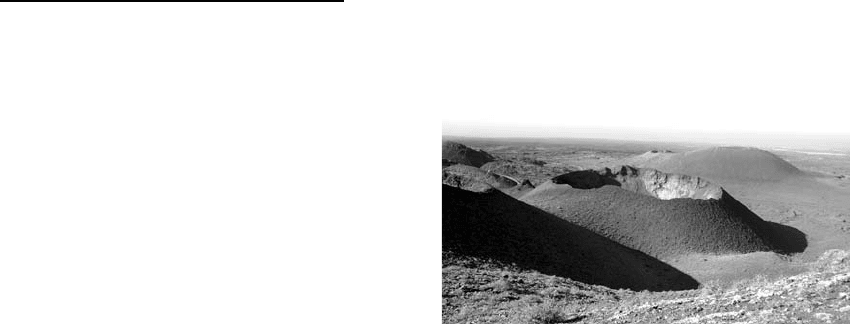
topography except where it is reworked into depres-
sions by secondary processes. The distribution of
material from a Plinian eruption is very strongly
influenced by the strength and direction of the
prevailing wind.
17.3.2 Strombolian (Hawaiian) eruptions
Strombolian or Hawaiian eruptions are charac-
terised by a spatter of molten lava that solidifies to
form glassy, vesicular fragments of basaltic composi-
tion known as scoria. The deposits of poorly sorted,
coarse lapilli, blocks and bombs are commonly inter-
bedded with lava to form small cones close to the vent
(Fig. 17.5). The scoria is largely air-fall material that
may be remobilised in grain flows if steep slopes are
built up on the sides of the cone. A characteristic
feature of some of the scoria in these eruptions is the
presence of Pele
´
e’s tears, which are small, pear-
shaped blobs of molten basaltic lava that solidify as
they fall through the air, and Pele
´
e’s hair, which are
filaments of solidified lava (Cas & Wright 1987).
17.3.3 Vulcanian eruptions
Eruptions of pyroclastic material from basaltic to
andesitic stratovolcanoes typically consist of relatively
small volumes of tephra ejected in a series of explo-
sions from a vent. These vulcanian eruptions result
from periodic breaches of the material that is plugging
the vent and involve blocks of both magma and coun-
try rock along with ash and lapilli (Cas & Wright
1987). The air-fall deposits of these eruptions are
characteristically stratified, due to the episodic char-
acter of the eruption, and poorly sorted, with bombs
and blocks commonly occurring with the finer
grained material (Figs 17.5 & 17.6).
17.4 FACIES ASSOCIATIONS IN
VOLCANIC SUCCESSIONS
The facies approach used in the analysis of terrige-
nous clastic and carbonate sediments can also be
applied to volcanic successions. Different processes of
transport and deposition of volcanic material have
been considered in the previous sections and these
can be recognised as having variable importance in
the different environments where volcanic activity is
dominant. As with all other depositional environ-
ments, a general division can be made between
those on land and others that are marine: further
subdivision in volcanic successions is largely deter-
mined by the characteristics of the magma (Cas &
Wright 1987).
17.4.1 Continental basalt provinces
In continental areas associated with a mantle hot spot
there may be eruption of large amounts of lava and
pyroclastic material from multiple vents and fissures
forming a flood basalt province. Valleys become
filled and pre-existing landforms completely envel-
oped when flood basalts cover many thousands of
square kilometres, with successions that can be sev-
eral thousand metres thick. Where individual vents
build up a volcano by the repeated eruption of basaltic
magmas they tend to have relatively gentle slopes and
are known as shield volcanoes. Associated eruptions
of basaltic pyroclastic material form scoria cones,
circular landforms that may be only a few hundred
metres across but with steep sides. Other morphologi-
cal types of crater composed of volcaniclastic material
are maars, which have steep-sided craters and gentle
outer slopes, tuff rings that have roughly equal
slopes either side of the rim and tuff cones that
have steep outer cones and small craters. These all
have relatively low preservation potential because
they are composed of loose material and are hence
readily reworked. Weathering processes acting on
basaltic material rapidly lead to breakdown and the
Fig. 17.6 A small ash cone formed by a pyroclastic eruption.
Facies Associations in Volcanic Successions 269

formation of pedogenic profiles (9.7) that may be
recognised, often as reddened units within the succes-
sion. Deposition of volcanic material over wide areas
affects the fluvial systems and rivers tend to incise to
form valleys within the succession. The fluvial depos-
its within these valleys can be preserved by overlying
volcanic units.
17.4.2 Continental stratovolcanoes
The classic volcanoes forming steep conical moun-
tains with a vent in a crater near the summit are
stratovolcanoes. These volcanic landforms are
composite bodies resulting from repeated eruptions
of pyroclastic falls, pyroclastic flows and relatively
short lava flows and they typically result from the
eruption of intermediate to acidic magmas. The depos-
its preserved in the stratigraphic record close to the
volcanic centre are likely to be ash fall products of
large Plinian eruptions and welded pumiceous tuffs
resulting from ignimbrites. Further away from the
vent the pyroclastic fall ashes are reworked to form
lahars and become mixed with terrigenous clastic
material in rivers, lakes and on shorelines.
17.4.3 Continental silicic volcanoes
Eruptions involving silicic material are typically
explosive resulting in the ejection of large amounts
of magma. This can result in the formation of a cal-
dera, an approximately circular depression with steep
walls formed by collapse associated with the eruption
of pyroclastic materials. The caldera itself will be the
site of accumulation of lavas and ignimbrites along
with epiclastic products of reworking by mass flows,
rivers and into lakes. Beyond the rim of the caldera
pumiceous pyroclastic flows and fall deposits will be
subject to epiclastic reworking by fluvial processes
that may result in large-scale redeposition, especially
of unwelded pyroclastic deposits.
17.4.4 Mid-ocean ridge basalts
The mid-ocean spreading ridges are sites of volumi-
nous extrusion of basaltic magma. Most of the extru-
sive material is in the form of pillowed and non-
pillowed lavas, with hydroclastites/hyaloclastites
forming as a result of the rapid quenching of the
lavas in contact with the seawater. Non-volcanic
material can occur between pillows where eruption
occurs on a sea floor of soft sediment and during
periods of volcanic quiescence pelagic material is
deposited between units of lava. The succession will
therefore consist of basaltic lava flows with variable
amounts of pillow structures, autobrecciated basaltic
material and either fine-grained limestones or cherty
mudrocks occurring between pillows and interbedded
with the basalts. Pyroclastic material only occurs
associated with the lavas in places where the eruption
occurs in shallow water. These strata are preserved
where pieces of ocean floor are tectonically emplaced
on continental margins as ophiolites (24.2.6).
17.4.5 Seamounts
Seamounts are sites of volcanism within areas of
oceanic lithosphere that develop into volcanic edifices
that are close to or above sea level. They form where
there is localised magmatism, for example over hot
spots in the mantle, and may be isolated from any
plate boundaries. The succession of volcanic rocks is
similar to that built up by mid-ocean ridge volcanism
but may be capped by shallow-marine facies such as
limestone reefs that form atolls on tops of the sea-
mounts. Preservation of a seamount in ancient suc-
cessions is only likely where there has been obduction
(24.2.6) of oceanic crust containing these edifices.
17.4.6 Marine stratovolcanoes
Large volcanoes build up from the sea floor to above
sea level in island arcs where subduction-related mag-
matism results in the extrusion of large amounts of
basaltic to andesitic magma. The subaerial parts of
the volcanic edifice will resemble continental strato-
volcanoes, consisting of assemblages of lavas, pyro-
clastic falls and flows. The associated epiclastic
deposits will be different in this setting because of
the effects of reworking by shallow marine processes
and redeposition of sediment by mass flows to form an
apron around the volcano. The redeposited facies
include the products of slumps, slides, avalanches,
debris flows and turbidity currents of volcaniclastic
material: they will occur in the marine succession
associated with shallow to deep-marine carbonate
270 Volcanic Rocks and Sediments

facies, pelagic deposits and pyroclastic air-fall ash
which is spread by wind from the volcano.
17.4.7 Submarine silicic volcanoes
Eruptions within continental crust in marine settings
result in the extrusion of magmas of silicic composi-
tion. The confining pressure of the water column
above the magma means that underwater eruptions
are less explosive because gases are less able to come
out of solution in the magma. Submarine silicic vol-
canism therefore gives rise to much more extensive
lavas of rhyolitic composition than is seen in conti-
nental successions. Hyaloclastites are extensively
developed as lava is rapidly chilled in contact with
seawater or soft, wet sediment, but pyroclastic pro-
ducts only form where the eruptions occur in shallow
water, where the processes are much more likely to be
explosive in character. Hydrothermal activity asso-
ciated with silicic volcanism results in the formation
of sulphide deposits.
17.5 VOLCANIC MATERIAL IN OTHER
ENVIRONMENTS
Volcaniclastic clasts have a poor preservation poten-
tial in aeolian environments because the processes of
abrasion and attrition during wind transport are too
severe for the relatively fragile grains to survive. Pres-
ervation of ashes is favoured by low-energy continen-
tal environments where there is active sediment
accumulation, such as lakes, which provide ideal con-
ditions for the preservation of an ash fall deposit in a
stratigraphic succession. Floodplain environments
may also be suitable but pedogenic and weathering
processes will rapidly alter the volcanic material. Ash
bands also occur bedded with coals in swamps and
mires where organic detritus is rapidly accumulating.
Volcanic deposits that can be classified as deltas are
rare, but have been documented as either cones
of lava and hyaloclastite advancing into the sea
(Porebski & Gradzinski 1990) or aprons of volcani-
clastic material (Nemec 1990a). Beach sands com-
posed of grains of basalt can be found along the
coasts of many volcanic islands; they exhibit a high
degree of textural maturity, but their compositional
maturity is very low, consisting mainly of unstable
lithic fragments. An association with carbonate
sediments is quite common and the fringes of volcanic
islands are ideal locations for carbonate sedimentation
because of the absence of terrigenous clastic detritus:
in the periods between volcanic eruptions faunal
communities are able to develop and provide a source
of carbonate as bioclastic sands or reef build-ups.
17.6 VOLCANIC ROCKS IN EARTH
HISTORY
17.6.1 Volcanic rocks in stratigraphy
Lavas and volcaniclastic deposits within sedimentary
successions play a key role in stratigraphy because,
unlike almost all other sedimentary rocks, they can be
dated by radiometric isotope analysis (21.2). The
absolute dates that can be determined from volcanic
rocks provide the time framework for the calibration
of stratigraphic schemes based on other criteria, par-
ticularly the fossils within the succession (20.1). In
situations where dating is based on an igneous rock
occurring as a layer within strata it is important to
distinguish between a unit that formed as a surface
flow, a lava, and a layer that was an intrusive body, a
sill. The date for a lava provides a date for that part of
the sedimentary succession, whereas the date for a sill
is some time after the sediments were deposited. Sills
may be identified by features that are not seen in lava
flows such as a baked margin, which provides evi-
dence of heating at the contact with both the beds
below and the beds above. Additionally, when tracing
the sill laterally it may be found to locally cut through
beds up or down stratigraphy, behaving as a dyke at
these points. Lava flows, on the other hand, may dis-
play characteristics that would not occur in sills such
as a pillow structure if the eruption occurred under
water, or a weathered top surface of the flow in the
case of subaerial eruptions. Severe weathering or
alteration of volcanic rocks causes problems for radio-
metric dating because it can make the ages obtained
unreliable.
17.6.2 Magnitude of volcanic events
Most eruptions are relatively small, producing a
steady stream of lava and/or the ejection of small
quantities of ash. However, periodically there are
more violent eruptions that eject many cubic
Volcanic Rocks in Earth History 271

kilometres of ash and volcanic gases. These larger
events are recognisable in the stratigraphic record as
thicker and more widespread deposits of volcanic ash
sometimes occurring in depositional environments
many hundreds of kilometres from the site of the
eruption. These ash bands are very useful marker
horizons as distinctive beds and have the additional
benefit of being potentially datable. The effects of a
large volcanic eruption may be experienced all over
the world. Airborne ash and aerosols (droplets of
water containing dissolved sulphates and nitrates)
from an eruption can be carried high into the atmo-
sphere where they affect the penetration of radiation
from the Sun and can result in temporary global
cooling. In comparison to volcanic eruption in geo-
logical history the recent large eruptions of Mount St
Helens in 1980 and Mount Pinatubo in 1991 were
relatively small events, involving between 1 and
10 km
3
of eruptive material. In comparison there
were eruptions in Yellowstone, northwest USA, in
the Quaternary that are thought to have produced
up to 2500 km
3
of ash (Smith & Braile 1994) and a
late Pleistocene event on Sumatra in western Indone-
sia deposited a layer of ash, the Toba Tuff, that can be
traced across large areas of the Bay of Bengal and
India (Ninkovitch et al. 1978).
17.6.3 Volcanicity and plate tectonics
The recognition of volcanigenic deposits in the strati-
graphic record and analysis of their chemistry pro-
vides important clues to the plate tectonics of the
past, making it possible to recognise ancient plate
boundaries a long way back through Earth history.
Most volcanicity around the world is associated
with plate margins, with chains of volcanic islands
related to subduction of oceanic plates. Volcanism
also occurs in extensional tectonic regimes along all
the oceanic spreading ridges and in intracontinental
rifts: strike-slip plate boundaries may also be sites of
volcanism. Exceptions to this pattern of association
with plate boundaries are volcanoes situated above
‘hot spots’, sites around the surface of the Earth
where mantle plumes provide exceptional amounts of
heat to the crust. Geochemical work has shown dis-
tinct chemical signatures for the volcanic rocks
associated with each of these different tectonic
settings and hence the occurrence of volcanic
successions in the stratigraphic record provides evi-
dence of the plate setting.
17.7 RECOGNITION OF VOLCANIC
DEPOSITS: SUMMARY
The single most important criterion for the recognition
of volcanigenic deposits is the composition of the mate-
rial. Lavas and primary volcaniclastic detritus rarely
contain any material other than the products of the
eruption, the nature of which depends on the chemical
composition of the magma and the nature of the erup-
tion. Recognition of the volcaniclastic origin of rocks in
the stratigraphic record becomes more difficult if the
material is fine-grained, altered or both. In hand speci-
men a fine-grained volcaniclastic rock can be confused
with a terrigenous clastic rock of similar grain size.
Microscopic examination of a thin-section usually
resolves the problem by making it possible to distinguish
the crystalline forms within the volcaniclastic deposit
from the eroded, detrital grains of terrigenous clastic
material. Alteration can destroy the original volcanic
fabric of the rock principally by breakdown of feldspars
and other minerals to clays: rocks of basaltic composi-
tion are particularly susceptible to alteration. Complete
alteration may mean that the original nature of the
material can be determined only from relict fabrics, such
as the outlines of the shapes of feldspar crystals remaining
despite total alteration to clay minerals, and the chemis-
tryoftheclaysasdeterminedbyXRDanalysis(2.4.4).
Characteristics of volcaniclastic deposits
. lithology – basaltic to rhyolitic composition with
lithic, crystal and glass fragments
. mineralogy – feldspar, other silicate minerals, some
quartz
. texture – poorly to moderately sorted
. bed geometry – may mantle or fill topography
. sedimentary structures – parallel bedding, dune and
antidune cross-bedding in pyroclastic flows
. palaeocurrents – cross-bedding may indicate pyro-
clastic flow direction
. fossils – rare except for plants and animals trapped
during ash falls and flows
. colour – from black in basaltic deposits to pale grey
rhyolitic material
. facies associations – pyroclastic deposits may occur
associated with any continental and shallow-marine
facies.
272 Volcanic Rocks and Sediments

FURTHER READING
Cas, R.A.F., & Wright, J.V. (1987) Volcanic Successions: Mod-
ern and Ancient. Unwin Hyman, London.
Fisher, R.V. & Schmincke, H-U. (1994) Volcaniclastic sedi-
ment transport and deposition. In: Sediment Transport and
Depositional Processes (Ed. Pye, K.). Blackwell Scientific
Publications, Oxford; 351–388.
Fisher, R.V. & Smith, G.A. (1991) Sedimentation in Volcanic
Settings. Special Publication 45, Society of Economic
Paleontologists and Mineralogists, Tulsa, OK.
Orton, G.J. (1995) Facies models in volcanic terrains:
time’s arrow versus time’s cycle. In: Sedimentary Facies
Analysis: a Tribute to the Teaching and Research of Harold G.
Reading (Ed. Plint, A.G.) Special Publication 22, Interna-
tional Association of Sedimentologists. Blackwell Science,
Oxford; 157–193.
Orton, G.J. (1996) Volcanic Environments. In: Sedi-
mentary Environments: Processes, Facies and Stratigra-
phy (Ed. Reading, H.G.). Blackwell Science, Oxford;
485–567.
Further Reading 273

18
Post-depositional Structures
and Diagenesis
A sediment body deposited on land or in the sea normally undergoes significant mod-
ification before it becomes a sedimentary rock. Physical, chemical and, to some extent,
biological processes act on the sediment at scales that range from the molecular to
basin-wide. Generally these processes change sediment into sedimentary rocks by
compacting loose detritus and adding material to create cements that bind the sediment
together. Chemical changes occur to form new minerals and organic substances, and
physical processes affect the layers on large and small scales. An important product of
these post-depositional processes is the formation and concentration of fossil fuels:
coal, oil and natural gas are all products of processes within sedimentary strata that
occur after deposition.
18.1 POST-DEPOSITIONAL
MODIFICATION OF SEDIMENTARY
LAYERS
Sediment is generally deposited as layers that may
contain features such as cross-bedding, wave ripples
or horizontal lamination formed during deposition:
these are referred to as primary sedimentary struc-
tures. The original layering and these sedimentary
structures may be subject to modification by fluid
movement and gravitational effects if the sediment
remains soft. Disruption of the sedimentary layers
may occur within minutes of deposition or may hap-
pen at any time up to the point when the material
becomes lithified. Soft-sediment deformation is the
general term for changes to the fabric and layering of
beds of recently deposited sediment. The deformation
structures are mostly formed as a result of sediment
instabilities caused by density contrasts and by move-
ment of pore fluids through the sediment.
When sediment is deposited in marine environ-
ments it is saturated with water, and many continen-
tal deposits are also saturated by groundwater. Burial
by more sediment usually leads to gradual expulsion
of the pore waters, except where the water gets
trapped within a layer by an impermeable bed
above. This trapped water becomes overpressured,
and when a crack in the overlying layer allows fluid
to be released it travels at high velocity upwards
(Leeder 1999). Rapidly moving pore water causes
fluidisation of the sediment, which is carried
upwards with the moving water. Finer sediment can
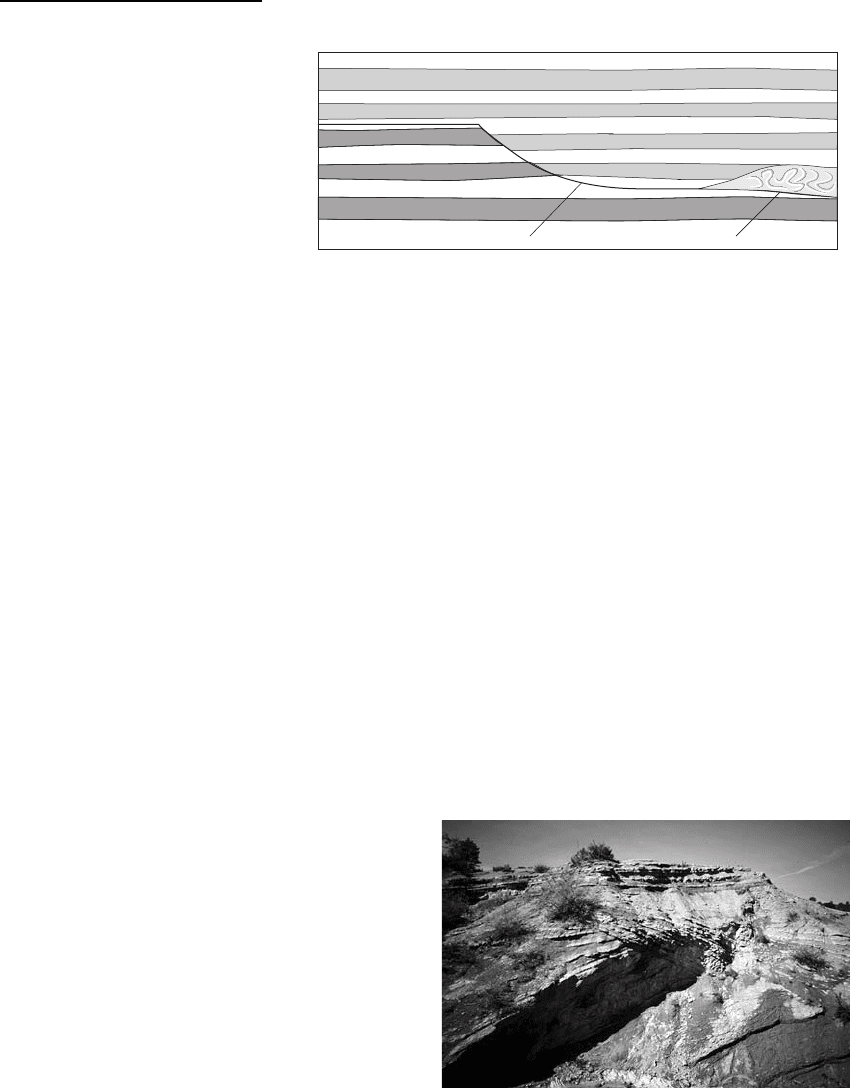
be more easily carried upwards, so the process of
elutriation occurs, as fine sand is carried away by
the fluid, leaving behind coarser, and more cohesive,
material. Liquefaction is a shorter-term process that
happens when a mass of saturated sediment is
affected by a shock, such as an earthquake, and
becomes momentarily liquid, behaving like a viscous
fluid. There is usually only very localised movement of
sediment and fluid during liquefaction.
Soft-sediment deformation takes a variety of forms
at various scales and can occur in any sediment
deposited subaqueously that retains some water after
deposition. They can be loosely grouped into struc-
tures due to sediment instabilities, liquefaction, fluid-
isation and loading, although these are not mutually
exclusive categories.
18.1.1 Structures due to sediment
instabilities
Slumps and slump scars
Slumps and slump scars (Figs 18.1 & 18.2) form as a
result of gravitational instabilities in sediment piles.
When a mass of sediment is deposited on a slope it is
often unstable even if the slope is only a matter of a
degree or so. If subjected to a shock from an earth-
quake or sudden addition of more sediment failure
may occur on surfaces within the sediment body
and this leads to slumping of material. Slumped
beds are deformed into layers that will typically
show a fold structure with the noses of the anticlines
oriented in the downslope direction. The surface left
as the slumped material is removed is a slump scar,
which is preserved when later sedimentation subse-
quently fills in the scar. Slump scars can be recognised
in the stratigraphic record as spoon-shaped surfaces
in three dimensions and they range from a few metres
to hundreds of metres across. They are common in
deltaic sequences but may also occur within any
material deposited on a slope.
Growth faults
There is a continuum of process and scale between
slump scars and growth faults, which are surfaces
within sedimentary succession along which there is
relative displacement. Growth faults are considered to
be synsedimentary structures, that is, they form
during the deposition of a package of strata. They
are most commonly found in delta-front successions
(12.6), where the depositional slope and the super-
position of mouth-bar sands on top of delta-front and
prodelta muds results in gravitational instabilities
within the succession (Collinson 2003; Collinson
et al. 2006). Failure occurs on weak horizons and
propagates upwards to form a spoon-shaped fault
(a listric fault) within the sedimentary succession
Fig. 18.1 Instabilities within the beds
result in parts of the succession slumping
to form deformed masses of material:
slump scars are the surfaces on which
movement occurs.
Sediment filling slump scar
Slump scar surface
Slumped material
Fig. 18.2 The layers of strata at different angles are a result
of slumps rotating the strata.
Post-depositional Modification of Sedimentary Layers 275
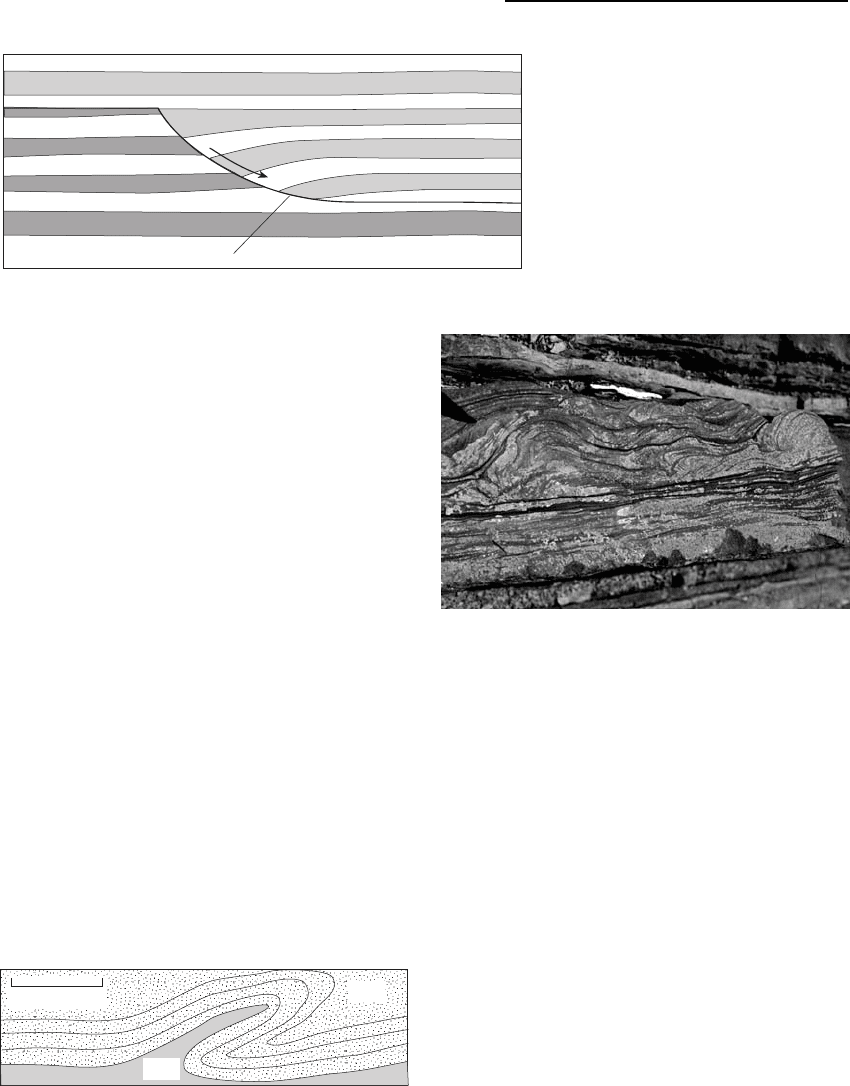
(Fig. 18.3). Movement of the beds above the fault over
the curved fault surface results in a characteristic rota-
tion of the beds. Growth faults can be distinguished
from post-depositional faulting because a single fault
affects only part of the succession, with overlying beds
unaffected by that fault.
18.1.2 Structures due to liquefaction
Convolute bedding and convolute lamination
The layering within sediments can be disrupted dur-
ing or after deposition by localised and small-scale
liquefaction of the material. The structures range
from slight oversteepening of cross-strata, to the
development of highly folded and contorted layers
called convolute lamination and convolute bed-
ding (Figs 18.4 & 18.5). These structures form
where the sediment is either deposited on a slight
slope or where there is a shear stress on the material
due to flow of overlying fluid (Leeder 1999; Collinson
et al. 2006). The folds in the layering tend to be
asymmetric, with the noses of the anticlines pointing
downslope or in the direction of the flow. Convolute
lamination is particularly common in turbidites,
where it can be seen within the laminated and
cross-laminated parts of the beds.
Overturned cross-stratification
Sands deposited by avalanching down the lee slope of
subaqueous dunes are loosely packed and saturated
with water. They are easily liquefied and can be
deformed by the shear stress caused by a strong cur-
rent over a set of cross-beds. Shearing of the upper
part of the cross-beds creates a characteristic form
called recumbent cross-bedding or overturned
cross-stratification (Fig. 18.6).
18.1.3 Structures due to fluidisation
Dish and pillar structures
Soft-sediment deformation structures formed by flui-
disation processes are often called dewatering struc-
tures (Fig. 18.7) as they result from the expulsion of
pore water from a bed. Dish structures are concave
disruptions to the layering in sediments a few centi-
metres to tens of centimetres across formed by the
strata thicken towards fault
Listric fault
Fig. 18.3 Faulting during sedimentation
results in the formation of a growth fault:
the layers to the right thickening towards
the fault are evidence of movement on the
fault during deposition.
sand
Convolute lamination, and convolute bedding
mud
cm10s cm
Fig. 18.4 Convolute lamination and convolute bedding
form as a result of local liquefaction of deposits.
Fig. 18.5 Convolute lamination in thinly bedded sandstone
and mudstone formed as a result of slumping.
276 Post-depositional Structures and Diagenesis
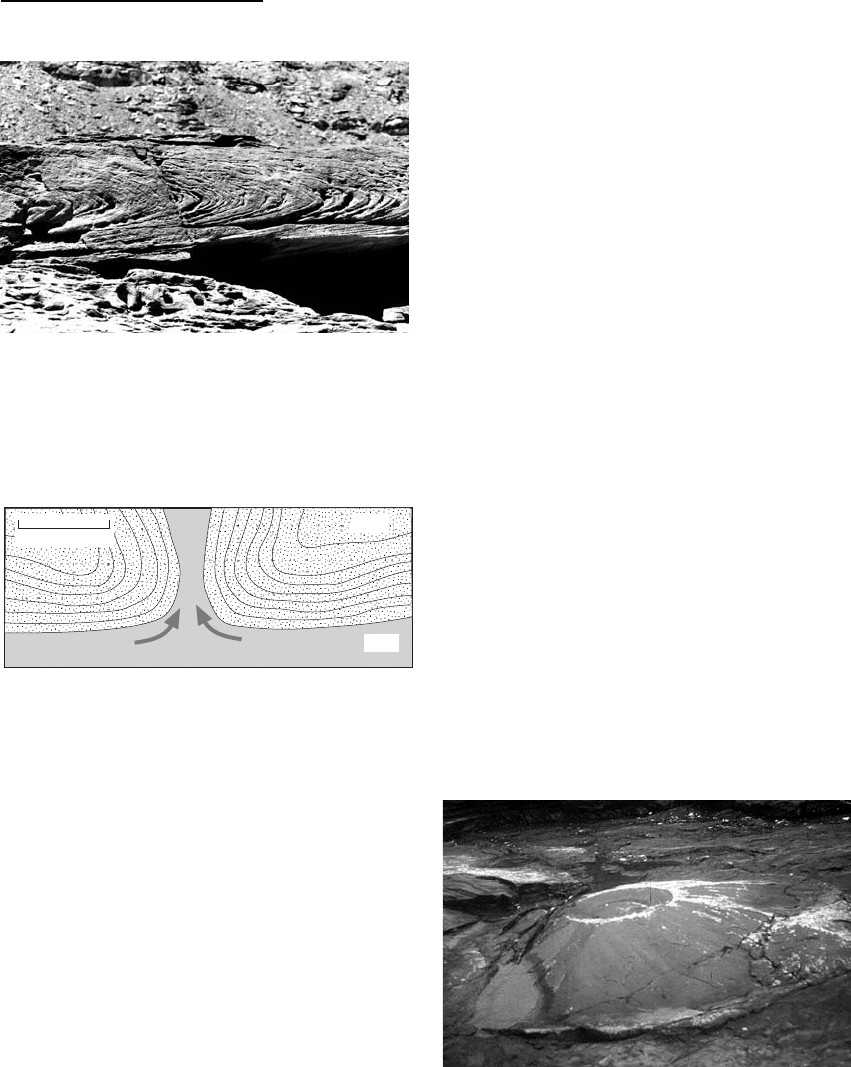
upward movement of fluid (Leeder 1999; Collinson
et al. 2006). They are often picked out by fine clay
laminae that are the cause of local barriers to fluid
flow within the sediment. In plan view the dish
structures form polygonal shapes. Pillar structures,
also known as elutriation pipes, are vertical
water-escape channels that can be simple tubes or
have a vertical sheet-like form. Dish and pillar struc-
tures often occur together, although they can form
separately.
Clastic dykes
Fluidisation of a large body of sediment in the subsurface
can result in elutriation of sediment and the formation
of vertical clastic dykes centimetres to tens of centi-
metres across. These sheet-like vertical bodies are
typically made of fine sand and they cross-cut other
beds. They form when a fracture occurs above an
overpressured bed and the upward rush of pore
waters carries sediment with it into the crack. The
sand may show some layering parallel to the walls
of the dyke but is otherwise structureless.
A distinction must be drawn between clastic dykes,
which are injected from below, and fissure fills
formed by the passive infill from above of fissures
and cracks in the underlying layers. Fissure fills form
where cracks occur at the surface due to earthquake
activity or where solution opens cracks in the process
of karstic weathering (6.6.3). They can usually be
distinguished from clastic dykes because they taper
downwards, can be filled with any size of clast (brec-
cia is common) and can show multiple phases of
opening and filling where they are earthquake-
related. The term ‘Neptunian dyke’ has been used
in the past for these fissure fills.
Sand volcanoes and extruded sheets
Liquified sediment brought to the surface in isolated
pipes emerges to form small sand volcanoes a
few tens of centimetres to metres across (Fig. 18.8)
(Leeder 1999; Collinson et al. 2006). These eruptions
of sand on the surface can be preserved only if low-
energy conditions prevent the sand being reworked by
currents. Sand brought to the surface through clastic
dykes can also spread out on the surface, usually as
an extruded sheet of sandy sediment. These sheets
can be difficult to recognise if the connection with an
underlying dyke cannot be established. Intrusions
Fig. 18.6 Overturned cross-stratification in sandstone beds
60 cm thick: these would have been originally deposited as
simple cross-beds by the migration of a subaqueous dune
bedform and subsequently the upper part of the cross-bed set
was deformed by the shear stress of a flow over the top.
Dewatering structures
cm10s cm
sand
mud
Fig. 18.7 Movement of fluid up from lower layers results in
the formation of dewatering structures.
Fig. 18.8 Movement of fluid up from lower layers incorpo-
rates sand that reaches the sediment surface to form a sand
volcano.
Post-depositional Modification of Sedimentary Layers 277
